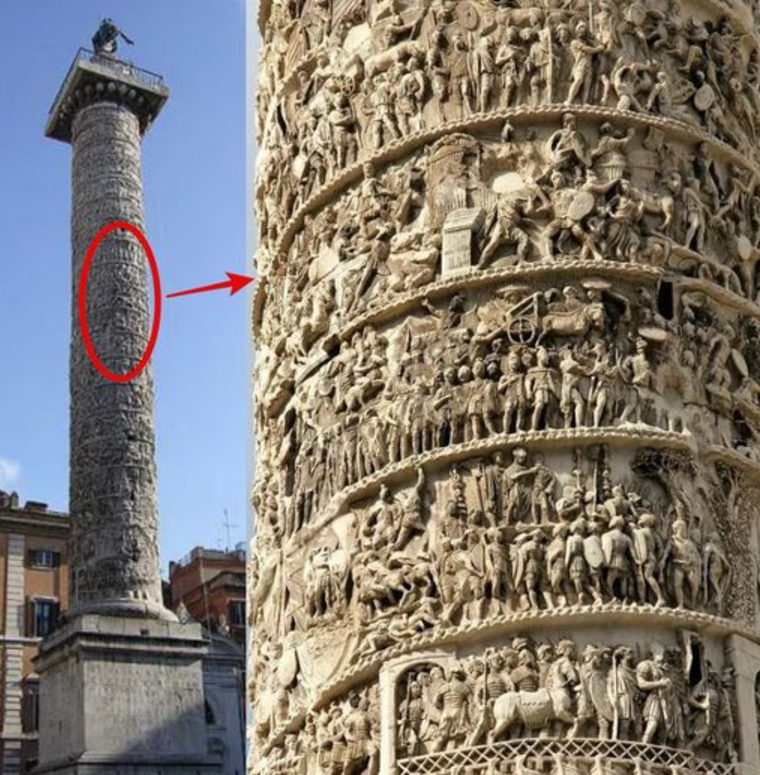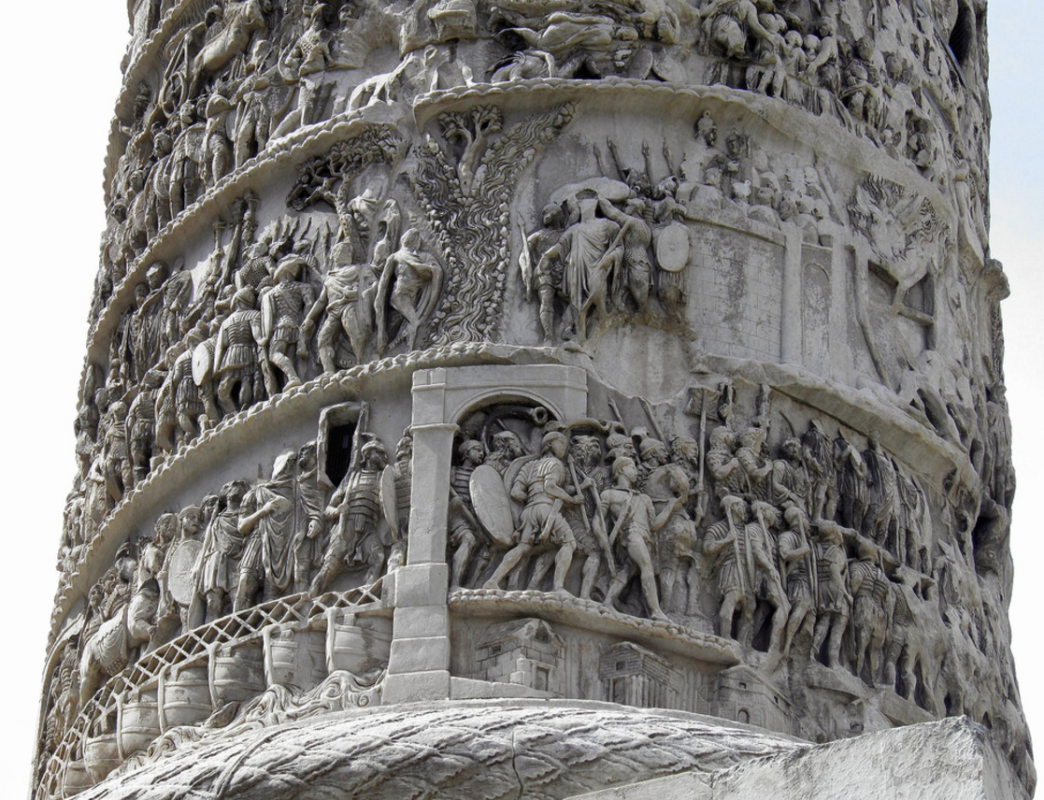Located in the heart of Rome at Piazza Colonna, the Column of Marcus Aurelius and Faustina is a remarkable testament to ancient Roman engineering and artistry. Erected around 180 AD, this iconic structure was commissioned by Emperor Commodus to honor his father, Marcus Aurelius, and his mother, Faustina. Its historical significance and intricate carvings make it a must-see for visitors to the Eternal City. Explore ancient Roman art with archeology.dulichvn.net
The History of the Column of Marcus Aurelius and Faustina
This towering column carries a rich legacy tied to one of Rome’s most revered emperors and his family.

1. Commissioning the Monument
Emperor Commodus commissioned the column as a tribute to his father, Marcus Aurelius, a philosopher-emperor renowned for his wisdom and Stoic writings, and his mother, Faustina. The column symbolized their deification and celebrated their contributions to the Roman Empire.
2. Connection to Victory
The column commemorates Marcus Aurelius’ military campaigns against the Germanic tribes and Sarmatians. Its reliefs vividly depict scenes of battles and divine interventions, underscoring the Emperor’s leadership and victories.
3. Placement in Piazza Colonna
Piazza Colonna, where the column stands today, was a central hub in ancient Rome. Its location reflects the importance of the monument as a cultural and political statement.
See more: The Bowder Stone: A Natural Wonder of the Lake District
Design and Architectural Marvels
The Column of Marcus Aurelius and Faustina showcases exceptional craftsmanship and innovation characteristic of Roman architecture.

1. Structure and Dimensions
Standing approximately 39 meters (128 feet) tall, the column is crafted from Carrara marble. Its spiraling reliefs ascend the shaft, creating a visual narrative that can be read from bottom to top.
2. The Intricate Reliefs
The column’s reliefs depict over 200 scenes from Marcus Aurelius’ military campaigns. The carvings highlight key moments such as battles, negotiations, and acts of mercy, offering insights into the emperor’s reign and the values of Roman society.
3. A Spiral Staircase Within
Inside the column is a narrow spiral staircase with 190 steps leading to the top. Originally, visitors could climb to the summit for panoramic views of the city, symbolizing a connection between the heavens and the earthly achievements of the Emperor.
Symbolism and Cultural Significance
The column is more than just a monument; it is a symbol of Roman power, divine favor, and artistic brilliance.

1. Celebrating Deification
The column underscores the deification of Marcus Aurelius and Faustina, showcasing how Roman emperors were often elevated to godlike status after death. This reflected the empire’s blending of political power with religious reverence.
2. Propaganda and Legacy
The carvings served as propaganda, reinforcing the emperor’s image as a victorious and benevolent leader. The monument also perpetuated the legacy of the Aurelius dynasty, cementing their place in Roman history.
3. Artistic Innovation
The column represents a shift toward more detailed and dynamic reliefs in Roman art, setting a standard for later monuments, such as the Column of Trajan.
See more: Cleopatras Palace: A Remarkable Underwater Discovery
Preservation and Modern Relevance
The Column of Marcus Aurelius and Faustina has withstood the test of time, offering modern visitors a glimpse into the grandeur of ancient Rome.

1. Efforts to Preserve the Monument
Over the centuries, the column has undergone restoration efforts to protect its intricate carvings from environmental damage and erosion. These efforts ensure that its historical and artistic value remains intact.
2. Accessibility for Visitors
While climbing the internal staircase is no longer allowed, visitors can admire the column’s details from Piazza Colonna. Informative plaques and nearby museums provide additional context for understanding its significance.
3. A Source of Inspiration
The column continues to inspire artists, architects, and historians, serving as a reminder of Rome’s enduring legacy as a center of culture and innovation.
Legacy of Marcus Aurelius and Faustina
The column serves as a lasting tribute to the remarkable lives of Marcus Aurelius and Faustina.

1. Marcus Aurelius: The Philosopher-Emperor
Known for his work Meditations, Marcus Aurelius is remembered as a ruler who valued wisdom, discipline, and virtue. His reign marked the height of Rome’s Golden Age.
2. Faustina: The Empress
Faustina, wife of Marcus Aurelius, was celebrated for her charity and dedication to her family. Her deification highlights her importance in Roman society and her role as a maternal figure to the empire.
3. Commodus: The Controversial Son
Though Commodus’ reign is often criticized, his decision to erect this column reflects his respect for his parents’ legacy, showcasing their enduring influence on Rome.
Visiting the Column Today
A trip to Piazza Colonna offers an opportunity to marvel at this ancient masterpiece and explore its surroundings

1. Piazza Colonna’s Historical Charm
The square is a vibrant area filled with cafes, shops, and other historical landmarks, making it a perfect starting point for a Roman adventure.
2. Nearby Attractions
Visitors can explore nearby attractions such as the Pantheon, Trevi Fountain, and Palazzo Chigi, adding depth to their cultural experience in Rome.
3. A Must-See for History Enthusiasts
The Column of Marcus Aurelius and Faustina remains a must-see for history buffs and art lovers alike, offering a unique glimpse into the grandeur of ancient Rome.
Conclusion
The Column of Marcus Aurelius and Faustina stands as a monumental achievement in Roman art and architecture. Erected in honor of two of Rome’s most revered figures, it encapsulates the values, power, and creativity of an empire at its peak.

CÁC TIN KHÁC
Mark Twain & Olivia Langdon: A 36-Year Love Story Filled with Laughter and Devotion
The Tollund Man: A 2,400-Year-Old Mystery Preserved in a Danish Bog
Skara Brae: Scotland’s Hidden Neolithic Village
Porta Nigra: The Hidden Depths of Trier’s Iconic Roman Gate